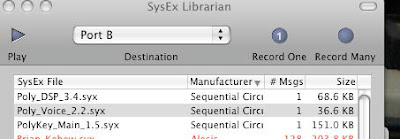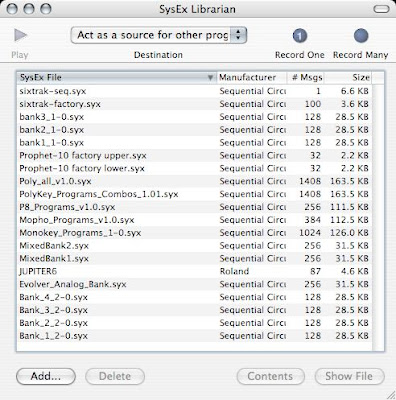 via this auction
via this auction SN 00553
See Perfect Circuit Audio (RSS) for more. Note this is onkloud9. Switching to the shop's name rather than the eBay account name moving forward. The link under More Stuff on the right has been updated as well.

EVERYTHING SYNTH
 via this auction
via this auction 
 via this auction
via this auction
 You can find the full article on AtariArchives.org
You can find the full article on AtariArchives.org This one spotted by Rhythmicons. Via silent_switchman on the Moog Music Forum: "Hello fellow Moogists!
This one spotted by Rhythmicons. Via silent_switchman on the Moog Music Forum: "Hello fellow Moogists! Now, like I say, I can't totally vouch at this point that this is the real thing, but it sure _looks_ like the real deal. What's that 'Kingdom Of South Turkey' bit on the label?? A bit of fun by Dr. Moog?
Now, like I say, I can't totally vouch at this point that this is the real thing, but it sure _looks_ like the real deal. What's that 'Kingdom Of South Turkey' bit on the label?? A bit of fun by Dr. Moog? via the Bob Moog Foundation where you'll find more pics and the full story.
via the Bob Moog Foundation where you'll find more pics and the full story. August Worley is an electrical engineer who shares a unique qualification with Bob Moog. August is the only person to have worked at Moog Music Buffalo, Big Briar, Inc. and Moog Music Asheville. He was part of the engineering team who helped Bob develop the Voyager. August was uniquely qualified to work on this modular project, as he formerly toured with ELP as the keyboard tech for Keith Emerson’s Monster Moog Modular. He also developed the pyrotechnics for Keith’s Moog ribbon controller.
August Worley is an electrical engineer who shares a unique qualification with Bob Moog. August is the only person to have worked at Moog Music Buffalo, Big Briar, Inc. and Moog Music Asheville. He was part of the engineering team who helped Bob develop the Voyager. August was uniquely qualified to work on this modular project, as he formerly toured with ELP as the keyboard tech for Keith Emerson’s Monster Moog Modular. He also developed the pyrotechnics for Keith’s Moog ribbon controller. via Brian Kehew:
via Brian Kehew:
 This Mini has the later ua726 containing VCO board installed. I don't want to open a debate about which generation of oscillators sound "best" but I will say that the VCOs track rock solid compared to other Minis I've played. When I detune the VCOs to get just the right fat spread I want, this is maintained up and down the keyboard and across the footages. Solid. But then again, never can I get them to perfectly line up and cancel each other out...that's the organic beauty of these oscillators, and why this instrument sounds so alive. Speaking of alive, the VCOs sound raw and huge. End of story."
This Mini has the later ua726 containing VCO board installed. I don't want to open a debate about which generation of oscillators sound "best" but I will say that the VCOs track rock solid compared to other Minis I've played. When I detune the VCOs to get just the right fat spread I want, this is maintained up and down the keyboard and across the footages. Solid. But then again, never can I get them to perfectly line up and cancel each other out...that's the organic beauty of these oscillators, and why this instrument sounds so alive. Speaking of alive, the VCOs sound raw and huge. End of story." flickr by andrewdalio
flickr by andrewdalio
 via this auction
via this auction via this auction
via this auction8jCh)7Q~~_1.JPG) I had the pleasure of both meeting and performing for Bob on multiple occasions, as I had been asked to join the Moog touring electronic music ensemble in the mid 70s by the then Moog V.P. of Marketing, Herb Deutsch. He is the man who co-invented the instrument in the summer of 1964 with Bob, and who was/is, an excellent snyth player as well.
I had the pleasure of both meeting and performing for Bob on multiple occasions, as I had been asked to join the Moog touring electronic music ensemble in the mid 70s by the then Moog V.P. of Marketing, Herb Deutsch. He is the man who co-invented the instrument in the summer of 1964 with Bob, and who was/is, an excellent snyth player as well. 8jHCJF!~~_1.JPG) The ensemble performed periodically for the next couple of years, so as a “road instrument,” it sustained multiple “car-door dings” if you will, but all of these were finished-over by a professional paint/stain restoration artist, and are now nearly imperceptible."
The ensemble performed periodically for the next couple of years, so as a “road instrument,” it sustained multiple “car-door dings” if you will, but all of these were finished-over by a professional paint/stain restoration artist, and are now nearly imperceptible."BJ)8jF!BsQ~~_1.JPG)

 Update: another screen shot sent in and confirmations in the comments.
Update: another screen shot sent in and confirmations in the comments. via this VEMIA auction
via this VEMIA auction












